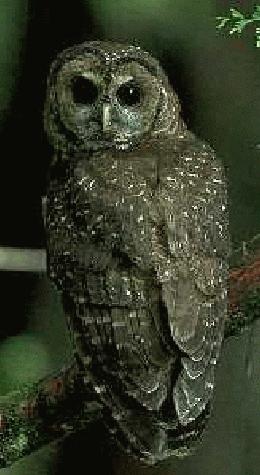On August 7, 1986, the U.S. Forest Service acts to protect the northern spotted owl (Strix occidentalis caurina ) from decline and extinction by limiting timber sales in mature portions of National Forests, which the animals need to live. The immediate impact is outcry from the forest products industry and from environmentalists. The industry complains that the measure goes too far and will cost thousands of jobs, and environmentalists claim that not enough is being done to protect the species. This is one in a long series of governmental actions and court decisions that will result in a reduction of more than 75 percent of the timber harvested annually from public lands.
Beginning in the early 1970s, biologists in Oregon recognized that the northern spotted owl needed old-growth forests (200-year-old forests that had never been logged or burned) for their habitats. The scientists estimated that one pair of owls needed hundreds of acres of forest habitat to survive. The spotted owl was regarded as an indicator species, one whose numbers reflected the health of other species and the forest ecosystem. In 1976, the National Forest Management Act required the U.S. Forest Service to make plans for the maintenance of "viable populations of existing native and desired non-native vertebrate species in the planning area.”
In 1984, the Forest Service developed an environmental impact statement and a forest management plan that required forest managers to consider owl habitat in the sales of timber. This placed in jeopardy the supply of logs for logging companies and lumber mills. The reduced number of logs had an economic impact in the entire forest products industry and in dozens of communities in the Northwest.
In 1986, the Forest Service proposed to withhold from sale 2,200 acres of forest for each of the 512 known nesting pairs of owls. This launched a debate over whether the measures were too restrictive on the forest products industry or not enough to protect the owls, with conflicting arguments and contradictory evidence. After much discussion and public comment, a final management plan was adopted in December 1987.
Endangered Species Act
Also in December 1987, the U.S. Fish and Wildlife Service declined to list the northern spotted owl under the Endangered Species Act. Environmentalists sued the Fish and Wildlife Service (FWS) to list the species. In the litigation, the agency admitted that it had taken into account economics and politics in its decision not to list. By law, economics and politics are not to be considered in listing a species.
In June 1989, the Fish and Wildlife Service proposed listing the owl as threatened under the Endangered Species Act. Most Northwest timber sales simply stopped and loggers and mill workers were laid off. Loggers and mill workers blamed environmentalists and the owl for the loss of jobs. Environmentalists blamed mechanization and log exports for the unemployment. Protests grew violent in some areas. Courts entered the dispute with decisions to resume or halt timber sales. The losing side appealed nearly every decision.
On June 26, 1990, the Fish and Wildlife Service formally listed the northern spotted owl as "threatened" under the Endangered Species Act throughout Oregon, Washington, and California. This impacted private and tribal lands in addition to federal lands since any "taking" of a species anywhere was prohibited. Taking included the loss of any habitat. The Fish and Wildlife Service delayed implementation until plans could be developed.
Judge Dwyer's Decision
On March 7, 1991, U.S. District Court Judge William Dwyer (1929-2002) ruled that the Forest Service Management Plan was inadequate under the law. By that time logging in National Forests had been cut by 50 percent.
In April 1994, the Clinton Administration presented Judge Dwyer with the Northwest Forest Plan that preserved 70 percent of federally owned old-growth forests -- reducing timber sales to less than a fourth of the 1980s. In addition the plan provided for restoration of watersheds that had been damaged by logging operations. Both sides in the dispute objected to the plan and went to court. In December 1994, Judge Dwyer held that the Northwest Forest Plan complied with the 1976 National Forest Management Act.

